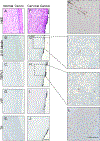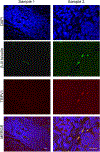Innervation of cervical carcinoma is mediated by cancer-derived exosomes
- PMID: 31003747
- PMCID: PMC6589362
- DOI: 10.1016/j.ygyno.2019.04.651
Innervation of cervical carcinoma is mediated by cancer-derived exosomes
Abstract
Objective: Recently, our laboratory identified sensory innervation within head and neck squamous cell carcinomas (HNSCCs) and subsequently defined a mechanism whereby HNSCCs promote their own innervation via the release of exosomes that stimulate neurite outgrowth. Interestingly, we noted that exosomes from human papillomavirus (HPV)-positive cell lines were more effective at promoting neurite outgrowth than those from HPV-negative cell lines. As nearly all cervical tumors are HPV-positive, we hypothesized that these findings would extend to cervical cancer.
Methods: We use an in vitro assay with PC12 cells to quantify the axonogenic potential of cervical cancer exosomes. PC12 cells are treated with cancer-derived exosomes, stained with the pan-neuronal marker (β-III tubulin) and the number of neurites quantified. To assess innervation in cervical cancer, we immunohistochemically stained cervical cancer patient samples for β-III tubulin and TRPV1 (sensory marker) and compared the staining to normal cervix.
Results: Here, we show the presence of sensory nerves within human cervical tumors. Additionally, we show that exosomes derived from HPV-positive cervical cancer cell lines effectively stimulate neurite outgrowth.
Conclusions: These data identify sensory nerves as components of the cervical cancer microenvironment and suggest that tumor- derived exosomes promote their recruitment.
Keywords: Cervical cancer; Exosomes; HPV; Innervation.
Copyright © 2019 The Authors. Published by Elsevier Inc. All rights reserved.
Figures




Similar articles
-
Cancer exosomes induce tumor innervation.Nat Commun. 2018 Oct 16;9(1):4284. doi: 10.1038/s41467-018-06640-0. Nat Commun. 2018. PMID: 30327461 Free PMC article.
-
ALA-PDT promotes HPV-positive cervical cancer cells apoptosis and DCs maturation via miR-34a regulated HMGB1 exosomes secretion.Photodiagnosis Photodyn Ther. 2018 Dec;24:27-35. doi: 10.1016/j.pdpdt.2018.08.006. Epub 2018 Aug 15. Photodiagnosis Photodyn Ther. 2018. PMID: 30118903
-
Mechanism of antiproliferative action of a new d-secoestrone-triazole derivative in cervical cancer cells and its effect on cancer cell motility.J Steroid Biochem Mol Biol. 2017 Jan;165(Pt B):247-257. doi: 10.1016/j.jsbmb.2016.06.013. Epub 2016 Jun 27. J Steroid Biochem Mol Biol. 2017. PMID: 27363663
-
[Studies on pathogenesis of cervical carcinoma based on the analysis of growth and differentiation mechanism of cervical epithelium].Nihon Sanka Fujinka Gakkai Zasshi. 1990 Aug;42(8):812-22. Nihon Sanka Fujinka Gakkai Zasshi. 1990. PMID: 2172418 Review. Japanese.
-
Exosomal Induction of Tumor Innervation.Cancer Res. 2019 Jul 15;79(14):3529-3535. doi: 10.1158/0008-5472.CAN-18-3995. Epub 2019 May 14. Cancer Res. 2019. PMID: 31088834 Free PMC article. Review.
Cited by
-
Advances in understanding cancer-associated neurogenesis and its implications on the neuroimmune axis in cancer.Pharmacol Ther. 2022 Nov;239:108199. doi: 10.1016/j.pharmthera.2022.108199. Epub 2022 Apr 29. Pharmacol Ther. 2022. PMID: 35490859 Free PMC article. Review.
-
A Holistic Perspective: Exosomes Shuttle between Nerves and Immune Cells in the Tumor Microenvironment.J Clin Med. 2020 Oct 31;9(11):3529. doi: 10.3390/jcm9113529. J Clin Med. 2020. PMID: 33142779 Free PMC article. Review.
-
Perineural Invasion in Cervical Cancer: A Hidden Trail for Metastasis.Diagnostics (Basel). 2024 Jul 14;14(14):1517. doi: 10.3390/diagnostics14141517. Diagnostics (Basel). 2024. PMID: 39061654 Free PMC article. Review.
-
Tumor Innervation: Cancer Has Some Nerve.Trends Cancer. 2020 Dec;6(12):1059-1067. doi: 10.1016/j.trecan.2020.07.005. Epub 2020 Aug 14. Trends Cancer. 2020. PMID: 32807693 Free PMC article. Review.
-
Ping-Pong-Tumor and Host in Pancreatic Cancer Progression.Front Oncol. 2019 Dec 16;9:1359. doi: 10.3389/fonc.2019.01359. eCollection 2019. Front Oncol. 2019. PMID: 31921628 Free PMC article. Review.
References
-
- Gynecologic Cancers: Cervical Cancer Statistics: Centers for Disease Control and Prevention; 2018. Available from: https://www.cdc.gov/cancer/cervical/statistics/index.htm.

